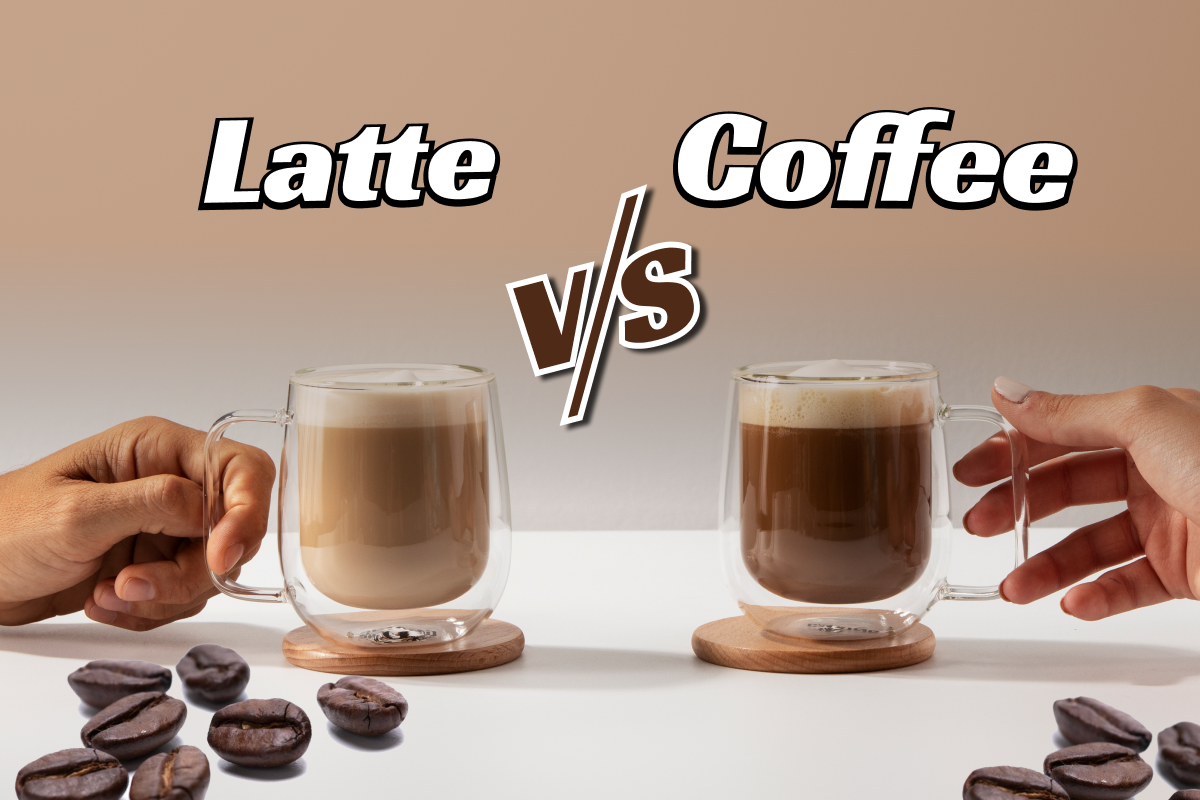Several people’s regular schedules wouldn’t be complete without including a caffeine-containing beverage. Caffeine is found in many different beverages and is consumed by many people every day, either first thing in the morning or midday. Coffee and lattes are two of the most well-liked caffeinated beverages among consumers. Both are caffeinated, however, the two are quite different in flavor, intensity, and method of preparation. Caffeine content is only one of many differences between these two drinks, and knowing all of them will help you make the best option.
Latte vs Coffee: The Basics
When it comes to coffee and latte, there is a world of nuanced distinctions between them.
A cup of coffee is brewed, delivering a bold, bitter flavor that tantalizes the tongue with its acidic notes. But a latte, with one espresso shot mixed with 3/4 cup of milk, offers a velvety smoothness that cascades over the palate like liquid caramel. Its richness adds a new dimension to the coffee-drinking experience.
Latte is also typically low to medium in strength, containing only 68 mg of caffeine, whereas coffee usually has a medium to high strength with a caffeine content ranging from 170mg to 220mg. In terms of calories, a latte has 110 calories per serving, whereas coffee has virtually none. Finally, a latte is usually made from a dark coffee roast and topped with milk foam, while coffee can be made from any coffee roast and has no topping. Both coffee and latte can be customized with sugar, coffee syrups, and creamer, but the latte typically has more options, including adding milk.
Latte vs Coffee: Which One Has More Cultural Significance?
While coffee has a long and rich history that spans centuries and multiple cultures, a latte is a more recent creation that has become popular mainly in the West. However, that doesn’t mean that a latte is any less significant or culturally relevant than coffee.
Latte vs Coffee: Taste and Flavor
The robust, earthy bitterness of coffee can be nectar for the soul or an overwhelming pleasure. Its flavor can be enjoyed in its raw glory, or it can be sweetened with sugar, cream, or milk for a more palatable experience.
However, for those who prefer a milder flavor, there is the velvety smoothness of a latte. The steamed milk adds a sweetness that tempers the bitterness of coffee and creates an altogether different brew – one that’s beloved by many and sure to please even the most discerning palate.
The Adaptability of Your Beverage
Coffee lovers often enjoy a steaming cup of joe every morning. However, sometimes a little variety is needed to spice up your caffeine intake. Lattes are often considered a delicious option, but how do they compare in terms of adaptability with coffee?
The Versatility of a Latte
Lattes are some of the most versatile drinks you can have. With a latte, you can choose to have it hot or iced, with a shot of espresso or tea, flavored or caffeinated. Whether it’s winter, spring, summer, or fall, you can find a latte recipe to match the season.
Furthermore, lattes are highly customizable. You can substitute milk for almond milk, soy milk, or heavy cream alternatives to meet dietary requirements. It’s virtually impossible to run out of ways to customize your latte.
The Flexibility of Coffee
While lattes are touted as versatile, regular coffee can come in just as many forms. Making coffee involves choosing the brewing process, grind size, and darkness of the roast. You can also add cream, sugar alternatives, milk, or other flavorings to get a customized taste.
Moreover, coffee has a broader range of options when it comes to brewing methods. From drip coffee to espresso, there is no shortage of ways to enjoy your cup of coffee. And the best part? You can add whip cream without changing the name!
Do Lattes Harm Your Health?
Simply said, a latte has more calories than a typical cup of black coffee since it has extra fat and sugar added to it. For starters, a latte requires a whole cup (or more) of milk. The calories in milk may be reduced by substituting it with a low-calorie alternative.
Who Should Drink Latte or Who Should Drink Coffee?
Latte or coffee, which one is the perfect match for you? Here’s a breakdown of who should drink what:
Latte:
- If you enjoy milky and creamy drinks
- If you prefer sweeter flavors
- If you want to experiment with different flavors and textures
- If you’re looking for a caffeine fix but don’t enjoy the strong taste of coffee
Coffee:
- If you prefer a strong and bold taste
- If you want to experiment with different brewing methods and beans
- If you prefer black coffee without any additional flavors
- If you’re looking for a quick and straightforward caffeine fix
Which is Better, Latte or Coffee?
It’s all subjective. Although a latte has great taste potential, the high milk volume may not be for everyone. Yet, people with a weaker tolerance for flavor may find coffee to be too much.
Consideration should also be given to the caffeine level of beverages like lattes and coffee. Caffeine content varies widely depending on the beverage; a latte’s shot of espresso may have as much as 63 milligrams, while a cup of coffee may have as much as 95 mg. Everything is relative to the amount of the drink, the technique of preparation, and the quality of the coffee or espresso beans.
Final Thoughts on Latte vs Coffee
Both lattes and coffee provide a caffeine boost and come from roasted beans, but their unique differences make up distinct flavor profiles that are worth experiencing. If you’re a coffee lover, don’t shy away from trying a latte, and vice versa. Exploring both options can lead to a newfound appreciation for the world of caffeinated beverages.
Tags: beveragescoffeelattelatte vs coffeewhich is better

